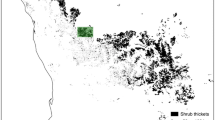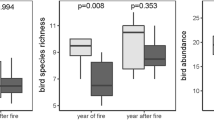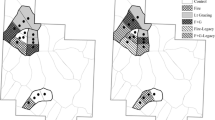Abstract
Fires, either natural or prescribed, are essential for conserving pyrogenic ecosystems; however, climate change is predicted to increase fire severity possibly causing negative impacts on native species diversity. Reptile and amphibian species may be particularly at risk given they are ectothermic species. The objective of this study was to better understand the impacts of fire severity on the herpetofaunal communities of the Florida scrub. The Florida scrub is an imperiled ecosystem that sustains over two-thirds of listed reptiles and amphibians in Florida. We conducted a field-based study to test taxonomic and functional diversity differences across four varying fire severities: unburned, low, medium and high. We also examined the association between herpetofaunal diversity and microhabitat variables across fire severities. We recorded 549 individuals, representing 23 reptile and amphibian species. The herpetofaunal community was not significantly different between the varying fire severities; however, a congruent trend occurred with the greatest diversity occurring at the intermediate fire severity plots. In addition, we showed leaf litter was significantly associated with species diversity. Interesting, the endangered sand skink, Plestiodon reynoldsi, was not recorded at the high fire severity plots, which could have implications on fire management practices of this federally threatened species. In this study, we demonstrated fire severity does not have a direct but instead an indirect effect on the native herpetofaunal species diversity in the Florida scrub. Thus, increasing fire severity consumption of leaf litter has the potential to detrimentally impact the Florida scrub herpetofaunal diversity. This study highlights the importance of fine-scale microhabitat variables, such as leaf litter, as an important indicator for biodiversity conservation.





Similar content being viewed by others
Data Availability
The datasets generated during and/or analyzed during the current study are available from the corresponding author.
References
Abrahamson W, Johnson A, Layne J, Peroni P (1984) Vegetation of the Archbold Biological Station, Florida: an example of the Southern Lake Wales Ridge. Fla Sci 47(4):209–250
Archbold Biological Station (2018) About us. http://www.archbold-station.org/
Archibald S, Bond W, Stock W, Fairbanks D (2005) Shaping the landscape: fire-grazer interactions in an African Savanna. Ecol Appl 15:96–109. https://doi.org/10.1890/03-5210
Ashton K, Knipps A (2011) Effects of fire history on amphibian and reptile assemblages in Rosemary scrub. J Herpetol 45(4):497–503
Balaji D, Raachakonda S, Rao S (2014) Drivers of reptile and amphibian assemblages outside the protected areas of Western Ghats. India J Nat Conserv 22(4):337–341. https://doi.org/10.1016/j.jnc.2014.03.004
Bohm M, Collen B, Baillie J, Bowles P, Chanson J, Cox N et al (2013) The conservation status of the world’s reptiles. Biol Conserv 157:372–385. https://doi.org/10.1016/j.biocon.2012.07.015
Chergui B, Pleguezuelos J, Fahd S, Santos X (2020) Modelling functional response of reptiles to fire in two Mediterranean forest types. Sci Total Environ 732:139205. https://doi.org/10.1016/j.scitotenv.2020.139205
Clarke K (1993) Non-parametric multivariate analyses of changes in community structure. Austral Ecol 18(1):117–143. https://doi.org/10.1111/j.1442-9993.1993.tb00438.x
Connell J (1978) Diversity in tropical rain forests and coral reefs. Sci 199(4335):1302–1310
Davis F, Moritz M (2013) Disturbance. Mech Encycl Biodivers 2:562–567. https://doi.org/10.1016/B978-0-12-384719-5.00034-4
Díaz-García J, Pineda E, Barrera F, Moreno C (2017) Amphibian species and functional diversity as indicators of restoration success in tropical montane forest. Biodivers Conserv 26:2569–2589. https://doi.org/10.1007/s10531-017-1372-2
Duncan B, Schmalzer P, Breininger D, Stolen E (2015) Comparing fuels reduction and patch mosaic fire regimes for reducing fire spread potential: a spatial modeling approach. Ecol Model 314:90–99. https://doi.org/10.1016/j.ecolmodel.2015.07.013
Elzer A, Pike D, Webb J, Hammill K, Bradstock R, Shine R (2013) Forest-fire regimes affect thermoregulatory opportunities for terrestrial ectotherms. Austral Ecol 38:190–198. https://doi.org/10.1111/j.1442-9993.2012.02391.x
Erwin W, Stasiak R (1979) Vertebrate mortality during the burning of a reestablished Prairie in Nebraska. Ame Midl Nat 101(1):247–249. https://doi.org/10.2307/2424922
Fauth J, Crother B, Slowinski J (1989) Elevational patterns of species richness, evenness, and abundance of the costa rican leaf-litter herpetofauna. Biotropica 21(2):178–185
Ferreira C, Santos X, Carretero M (2016) Does ecophysiology mediate reptile responses to fire regimes? Eviden Iberian Lizards Peerj 4:2107. https://doi.org/10.7717/peerj.2107
Fontaine J, Kennedy P (2012) Meta-analysis of avian and small-mammal response to fire severity and fire surrogate treatments in U.S. fire-prone forests. Ecol Appl 22(5):1547–1561. https://doi.org/10.1890/12-0009.1
Furnas B, Goldstein B, Figura P (2022) Intermediate fire severity diversity promotes richness of forest carnivores in California. Div Dist 28:493–505. https://doi.org/10.1111/ddi.13374
Gainsbury AM (2020) Influence of size, sex, and reproductive status on the thermal biology of endemic Florida scrub lizards. Ecol Evol. https://doi.org/10.1002/ece3.689713080-1308
Gainsbury A, Colli G (2019) Phylogenetic community structure as an ecological indicator of anthropogenic disturbance for endemic lizards in a biodiversity hotspot. Ecol Indic 103:766–773. https://doi.org/10.1016/j.ecolind.2019.03.008
Gainsbury A, Meiri S (2017) The latitudinal diversity gradient and interspecific competition: no global relationship between lizard dietary niche breadth and species richness. Glob Ecol Biogeogr 26:563–572. https://doi.org/10.1111/geb.12560
Greenberg C, Moorman C, Matthews-Snoberger C, Waldrop T, Simon D, Heh A, Hagan D (2018) Long-term herpetofaunal response to repeated fuel reduction treatments. J Wildl Manag 82(3):553–565. https://doi.org/10.1002/jwmg.21402
Greenberg C, Waldrop T (2008) Short-term response of reptiles and amphibians to prescribed fire and mechanical fuel reduction in a southern Appalachian upland hardwood forest. For Ecol Manag 255:2883–2893. https://doi.org/10.1016/j.foreco.2008.01.064
Greenberg C, Neary D, Harris L (1994) Effect of high-intensity wildfire and silvicultural treatments on reptile communities in sand-pine scrub. Con Biol 8:1047–1057. https://doi.org/10.1046/j.1523-1739.1994.08041047.x
Halstead N (2007) Long term effects of prescribed fire on reptile and amphibian communities in Florida sandhill. Graduate Thesis and Dissertations. http://scholarcommons.usf.edu/etd/2199
Hossack B, Eby L, Guscio G, Corn P (2009) Thermal characteristics of amphibian microhabitats in a fire-disturbed landscape. For Ecol Manag 258:1414–1421. https://doi.org/10.1016/j.foreco.2009.06.043
Howze J, Smith L (2021) The influence of prescribed fire on site selection in snakes in the longleaf pine ecosystem. For Ecol Manag. https://doi.org/10.1016/j.foreco.2020.118703
Hromada S, Howey C, Dickinson M, Perry R, Roosenburg W, Gienger CM (2018) Response of reptile and amphibian communities to the reintroduction of fire in an oak/hickory forest. For Ecol Manag 428:1–13. https://doi.org/10.1016/j.foreco.2018.06.018
Hu Y, Doherty T, Jessop T (2020) How influential are squamate reptile traits in explaining population responses to environmental disturbance? Wildl Res 47(3):249–259. https://doi.org/10.1071/WR19064
Hu Y, Kelly L, Gillespie G, Jessop T (2016) Lizard response to forest fire and timber harvesting: Complementary insights from species and community approaches. For Ecol Manag 379:206–215. https://doi.org/10.1016/j.foreco.2016.07.040
Hu Y, Urlus J, Gillespie G, Letnic M, Jessop T (2013) Evaluating the role of fire disturbance in structuring small reptile communities in temperate forests. Biol Conserv 22:1949–1963. https://doi.org/10.1007/s10531-013-0519-z
Jacobsen C, Brown D, Flint W, Schuler J, Schuler T (2020) Influence of Prescribed fire and forest structure on woodland salamander abundance in the central Appalachians, USA. For Ecol Manag. https://doi.org/10.1016/j.foreco.2020.118185
Keeley J (2009) Fire intensity, fire severity and burn severity: a brief review and suggested usage. Int J Wildland Fire 18:116–126. https://doi.org/10.1071/WF07049
Kuchinke D, Stefano J, Sitters H, Loyn R, Gell P, Palmer G (2020) Prescribed burn severity has minimal effect on common bird species in a fire-prone forest ecosystem. For Ecol Manag. https://doi.org/10.1016/j.foreco.2020.118437
Laliberté E, Legendre P, Shipley B (2014) FD: measuring functional diversity from multiple traits, and other tools for functional ecology. R package version 1.0–12.
Lazarina M, Devalez J, Neokosmidis L, Sgardelis S, Kallimanis A, Tscheulin T, Tsalkatis P, Kourtidou M, Mizerakis V, Nakas G, Palaiologou P, Kalabokidis K, Vujic A, Petanidou T (2019) Moderate fire severity is best for the diversity of most of the pollinator guilds in Mediterranean pine forests. Ecol 100(3):1–14
Leavitt D, Schalk C (2018) Functional perspectives on the dynamics of desert lizard assemblages. J Arid Environ 150:34–41. https://doi.org/10.1016/j.jaridenv.2017.11.014
Lemmon P (1957) A new instrument for measuring forest overstory density. J for 55(9):667–668
Magurran A (1988) Ecological diversity and its measurement. Springer, Netherlands. http://search.ebscohost.com.ezproxy.lib.usf.edu
Main K, Menges E (1997) Station fire management plan. Land Manag. Publ., p 97
Martin S, Rautsaw R, Robb F, Bolt M, Parkinson C, Seigel R (2017) Set AHDriFT: applying game cameras to drift fences for surveying herpetofauna and small mammals. Wildl Soc Bull 41(4):804–809. https://doi.org/10.1002/wsb.805
Mason N, Mouillot W, Lee W, Wilson J (2005) Functional richness, functional evenness and functional divergence: the primary components of functional diversity. Oikos 111:112–118
McCoy E, Britt E, Catenazzi A, Mushinsky H (2013) Fire and herpetofaunal diversity in the florida scrub ecosystem. Nat Areas J 33(3):316–326. https://doi.org/10.3375/043.033.0310
McCoy E, Mushinsky H (1994) Effects of fragmentation on the richness of vertebrates in the florida scrub habitat. Ecol 75(2):446–457
Menges E, Main K, Pickert R, Ewing K (2017) Evaluating a fire management plan for fire regime goals in a florida landscape. Nat Areas J 37(2):212–227
Meshaka W, Layne J (2002) Herpetofauna of a long-unburned sandhill habitat in South-Central Florida. Fla. Sci. 65(1):35–50
Moi D, Garcia-Rios R, Hong Z, Daquila B, Roger M (2020) Intermediate disturbance hypothesis in ecology: a literature review. Ann Zool Fenn 57(1–6):67–78. https://doi.org/10.5735/086.057.0108
Moseley K, Castleberry S, Schweitzer S (2003) Effects of prescribed fire on herpetofauna in bottomland hardwood forests. Southeast Nat 2(4):475–486
Munoz A, Felicisimo A, Santos X (2019) Assessing the resistance of a breeding amphibian community to a large wildlife. Acta Oecologica 99:103439. https://doi.org/10.1016/j.actao.2019.06.002
Mushinsky H (1985) Fire and The Florida Sandhill herpetofaunal community: with special attention to responses of Cnemidophorus sexlineatus. Herpetol 41(3):333–342
Noss RF, Platt WJ, Sorrie BA, Weakley AS, Means DB, Costanza J, Peet RK (2015) How global biodiversity hotspots may go unrecognized: lessons from the North American Coastal Plain. Divers Distrib 21(2):236–244
Oksanen J, Blanchet G, Friendly M, Kindt R, Legendre P, McGlinn D, Minchin P, O'Hara R, Simpson G, Solymos P, Stevens H, Szoecs E, Wagner H (2019) vegan: Community ecology package. R package version 2.5-6. https://CRAN.R-project.org/package=vegan
Penman T, Keith D, Elith J, Mahony M, Tingley R, Baumgartner J, Regan T (2015) Interactive effects of climate change and fire on metapopulation viability of a forest-dependent frog in south-eastern Australia. Biol Conserv 190:142–153. https://doi.org/10.1016/j.biocon.2015.05.020
Perry R, Rudolph D, Thill R (2009) Reptile and amphibian responses to restoration of fire-maintained pine woodlands. Restor Ecol 17(6):917–927. https://doi.org/10.1111/j.1526-100X.2009.00521.x
Pilliod D, Bury R, Hyde E, Pearl C, Corn P (2003) Fire and amphibians in North America. Forest Ecol Manag 178:163–181. https://doi.org/10.1016/S0378-1127(03)00060-4
Pough R (2016) Herpetology, 4th edn. Sinauer Associates Inc, Publishers
Price B, Kutt AS, McAlpine CA (2010) The importance of fine-scale savanna heterogeneity for reptiles and small mammals. Biol Conserv 143:2504–2513. https://doi.org/10.1016/j.biocon.2010.06.017
QGIS Development Team (2018) QGIS Geographic Information System. Open Source Geospatial Foundation Project. http://qgis.osgeo.org
R Core Team (2019) R: A language and environment for statistical computing. R Foundation for Statistical Computing, Vienna, Austria. https://www.R-project.org/
Richter C, Rejmanek M, Miller J, Welch K, Weeks J, Safford H (2019) The species diversity x fire severity relationship is hump-shaped in semiarid yellow pine and mixed conifer forests. Ecosphere 10(10):e02881. https://doi.org/10.1002/ecs2.2882
Roberts S, Wagtendonk J, Miles A, Kelt D, Lutz J (2008) Modeling the effects of fire severity and spatial complexity on small mammals in Yosemite National Park. California Fire Ecol 4(2):83–104. https://doi.org/10.4996/fireecology.0402083
Robertson J, Fitzpatrick S, Rothermel B, Chan L (2018) Fire does not strongly affect genetic diversity or structure of a common treefrog in the endangered Florida Scrub. J Hered 109(3):243–252. https://doi.org/10.1093/jhered/esx088
Santos X, Belliure J, Goncalves J, Pausas J (2022) Resilience of reptiles to megafires. Ecol Appl. https://doi.org/10.6084/m9.figshare.16553607
Santos X, Cheylan M (2013) Taxonomic and functional response of a Mediterranean reptile assemblage to a repeated fire regime. Biol Conserv 168:90–98. https://doi.org/10.1016/j.biocon.2013.09.008
Taylor JE, Ellis MV, Williams N, Kloecker U (2020) Responses of birds and reptiles in Warrumbungle national park after the extensive 2013 wildfire. In: Proceedings of the Linnean Society of New South Wales (142)
Timm S, Wolf A, Gao X, Kellner K (2020) Assessing multi-scale habitat relationships and responses to forest management for cryptic and uncommon herpetofauna in the Missouri Ozarks USA. For Ecol Manag. https://doi.org/10.1016/j.foreco.2020.117892
Vonesh J (2001) Patterns of richness and abundance in a tropical African leaf-litter herpetofauna. Biotropica 33(3):502–510
Webb J, Shine R (2007) Different effects of an intense wildfire on survival of sympatric snakes. The J Wildl Manag 72(6):1394–1398. https://doi.org/10.2193/2007-515
Weekley C, Menges E, Pickert R (2008) An ecological map of florida’s lake wales ridge: a new boundary delineation and an assessment of Pos-Columbian habitat loss. Fla Sci 71(1):45–64
Westgate M, Driscoll D, Lindenmayer D (2012) Can the intermediate hypothesis and information on species traits predict anuran responses to fire? Oikos 121:1516–1524. https://doi.org/10.1111/j.1600-0706.2011.19863.x
Whitfield S, Reider K, Greenspan S, Donnelly M (2014) Litter dynamics regulate population densities in a declining terrestrial herpetofauna. Copeia 3:454–461. https://doi.org/10.1643/CE-13-061
Wickham H (2016) ggplot2: Elegant graphics for data analysis. Springer-Verlag, New York
Zuniga A, Rau J, Jaksic F, Vergara P, Encina-Montoya F, Fuentes-Ramirez A (2021) Rodent assemblage composition as indicator of fire severity in a protected area of south-central Chile. Austral Ecol 46:249–260. https://doi.org/10.1111/aec.12975
Acknowledgements
Thank you to the personnel at Archbold Biological Station, particularly Dr. Betsie Rothermel, Mandy West and Kevin Main. Michelle Lindsay wants to personally thank her family for supporting her in her continued education and most of all her husband Conner Lindsay for the constant moral support. This research was funded by a USF graduate research grant to Michelle Lindsay. Reptiles and amphibians were collected under the scientific collection permit # LSSC-20-00040 issued by the Florida Fish and Wildlife Conservation Commission. All protocols were reviewed and accepted by the USF Institutional Animal Care and Use Committee, IACUC protocol # W 1500008013.
Funding
This research was supported by a graduate student research grant from the University of South Florida, St. Petersburg campus to Michelle Lindsay.
Author information
Authors and Affiliations
Contributions
All authors contributed to the study conception and design. Material preparation, data collection and analysis were performed by Michelle Lindsay and Alison M. Gainsbury. The first draft of the manuscript was written by Michelle Lindsay and all authors commented on previous versions of the manuscript. All authors read and approved the final manuscript.
Corresponding author
Ethics declarations
Conflict of interest
The authors declare no conflicts of interest.
Ethical approval
This research was conducted under IACUC protocol # W 1500008013 and Florida Fish and Wildlife Conservation Commission, scientific collection permit #LSSC-20–00040.
Informed consent
All authors agree to this submission.
Consent for publication
Not applicable.
Additional information
Communicated by Dirk Schmeller.
Publisher's Note
Springer Nature remains neutral with regard to jurisdictional claims in published maps and institutional affiliations.
Supplementary Information
Below is the link to the electronic supplementary material.
Rights and permissions
Springer Nature or its licensor (e.g. a society or other partner) holds exclusive rights to this article under a publishing agreement with the author(s) or other rightsholder(s); author self-archiving of the accepted manuscript version of this article is solely governed by the terms of such publishing agreement and applicable law.
About this article
Cite this article
Lindsay, M.N., Lewis, D.B., Halstead, N. et al. Fire severity effects on the herpetofaunal diversity of the Florida scrub, a biodiversity hotspot. Biodivers Conserv 32, 1857–1878 (2023). https://doi.org/10.1007/s10531-023-02581-3
Received:
Revised:
Accepted:
Published:
Issue Date:
DOI: https://doi.org/10.1007/s10531-023-02581-3




